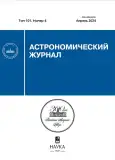Hall effects and diamagnetic cavity collapse during a laser plasma cloud expands into a vacuum magnetic field
- Authors: Chibranov А.А.1, Shaikhislamov I.F.1, Berezutskiy А.G.1, Posukh V.G.1, Trushin P.А.1, Zakharov Y.P.1, Miroshnichenko I.B.1, Rumenskikh М.S.1, Terekhin V.А.2
-
Affiliations:
- Institute of Laser Physics Siberian Branch of the Russian Academy of Sciences
- Russian Federal Nuclear Center, All-Russian Research Institute of Experimental Physics
- Issue: Vol 101, No 4 (2024)
- Pages: 379-388
- Section: Articles
- Published: 08.10.2024
- URL: https://gynecology.orscience.ru/0004-6299/article/view/647619
- DOI: https://doi.org/10.31857/S0004629924040082
- EDN: https://elibrary.ru/KFBBML
- ID: 647619
Cite item
Abstract
This paper describes the results of a laboratory experiment on the sub-Alfven expansion of a quasi-spherical laser plasma cloud into a vacuum magnetic field in the regime of nonmagnetized ions. The role of Hall fields and currents in the anomalously fast dynamics of the magnetic field during the collapse phase of a diamagnetic cavity is considered. Detailed spatial measurements of the azimuthal Hall fields configuration are demonstrated and their relationship to diamagnetic cavity collapse is determined. As a result of the experiment, data were obtained confirming the hypothesis about the transfer of the main magnetic field by the movement of electrons associated with Hall currents.
Full Text
About the authors
А. А. Chibranov
Institute of Laser Physics Siberian Branch of the Russian Academy of Sciences
Author for correspondence.
Email: chibranov2013@yandex.ru
Russian Federation, Novosibirsk
I. F. Shaikhislamov
Institute of Laser Physics Siberian Branch of the Russian Academy of Sciences
Email: chibranov2013@yandex.ru
Russian Federation, Novosibirsk
А. G. Berezutskiy
Institute of Laser Physics Siberian Branch of the Russian Academy of Sciences
Email: chibranov2013@yandex.ru
Russian Federation, Novosibirsk
V. G. Posukh
Institute of Laser Physics Siberian Branch of the Russian Academy of Sciences
Email: chibranov2013@yandex.ru
Russian Federation, Novosibirsk
P. А. Trushin
Institute of Laser Physics Siberian Branch of the Russian Academy of Sciences
Email: chibranov2013@yandex.ru
Russian Federation, Novosibirsk
Yu. P. Zakharov
Institute of Laser Physics Siberian Branch of the Russian Academy of Sciences
Email: chibranov2013@yandex.ru
Russian Federation, Novosibirsk
I. B. Miroshnichenko
Institute of Laser Physics Siberian Branch of the Russian Academy of Sciences
Email: chibranov2013@yandex.ru
Russian Federation, Novosibirsk
М. S. Rumenskikh
Institute of Laser Physics Siberian Branch of the Russian Academy of Sciences
Email: chibranov2013@yandex.ru
Russian Federation, Novosibirsk
V. А. Terekhin
Russian Federal Nuclear Center, All-Russian Research Institute of Experimental Physics
Email: chibranov2013@yandex.ru
Russian Federation, Sarov
References
- P.A. Bernhardt, R.A. Roussel‐Dupre, M.B. Pongratz, G. Haerendel, A. Valenzuela, D.A. Gurnett, and R.R. Anderson, J. Geophys. Res. Space Phys. 92, 5777 (1987).
- P.A. Bernhardt, Physics of Fluids B: Plasma Physics 4, 2249 (1992).
- N.A. Krall and P.C. Liewer, Phys. Rev. A 4, 2094 (1971).
- A.B. Hassam and J.D. Huba, Geophys. Res. Lett. 14 (1), 60 (1987).
- Y.P. Zakharov, A.M. Orishich, A.G. Ponomarenko and V.G. Posukh, Plasma Phys. Rep. 12, 674 (1986).
- И.М. Подгорный и Р.З. Сагдеев, УФН. 98, 409 (1969).
- K. Schindler, Reviews of Geophysics 7 (1–2), 51 (1969).
- R.C. Davidson and N.T. Gladd, Phys. Fluids. 18, 1327 (1975).
- N.T. Gladd, Plasma Phys. 18, 27 (1976).
- P.C. Liewer and R.C. Davidson, Nucl. Fusion 17, 85 (1977).
- B.H. Ripin, E.A. McLean, C.K. Manka, C. Pawley, J.A. Stamper, T.A. Peyser, A.N. Mostovych, J. Grun, A.B. Hassam, and J. Huba, Phys. Rev. Lett. 59, 2299 (1987).
- S. Okada, K. Sato and T. Sekiguchi, Jpn. J. Apl. Phys. 20, 157 (1981).
- A.G. Berezutsky, A.A. Chibranov, M.A. Efimov, V.G. Posukh, M.S. Rumenskikh, P.A. Trushin, I.B. Miroshnichenko, Yu.P. Zakharov, V.A. Terekhin and I.F. Shaikhislamov, Plasma Phys. Rep. 49, 351 (2023).
- Yu.P. Zakharov, A.M. Orishich, A.G. Ponomarenko and I.F. Shaikhislamov, in Proc. 10th European School Plasma Physics (Tbilisi). 184 (1990).
- S.I. Vainshtein, S.M. Chitre and A.V. Olinto, Phys. Rev. E 61, 4422 (2000).
- A.M. Bergel’son, Yu.P. Raizer and S.T. Surzhikov, J. Appl. Mech. Tech. Phys. 32, 316 (1991).
- А.Collette and W. Gekelman, Phys. Rev. Lett. 105, 195003 (2010).
- А.Collette and W. Gekelman, Phys. Plasmas 18, 055705 (2011).
- C.P. Escoubet, M. Fehringer and M. Goldstein, Ann. Geophys. 19, 1197 (2001).
- J.L. Burch, T.E. Moore, R.B. Torbert and R.B. Giles, Space Sci. Rev. 199, 5 (2016).
- А.М. Оришич, В.Г. Посух, В.Н. Снытников Мощные СO2-лазеры для плазменных экспериментов и технологии (Сборник ИТПМ, Новосибирск, 56, 1986).
- Ю.П. Захаров, А.М. Оришич и А.Г. Пономаренко Лазерная плазма и лабораторное моделирование нестационарных космических процессов (ИТПМ СО АН СССР, Новосибирск, ответственный редактор Н. Г. Преображенский, 219, 1988).
Supplementary files
















